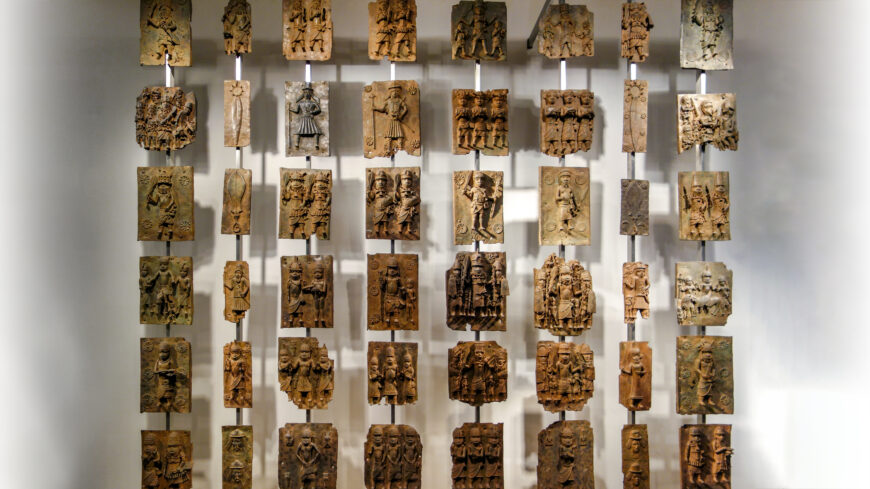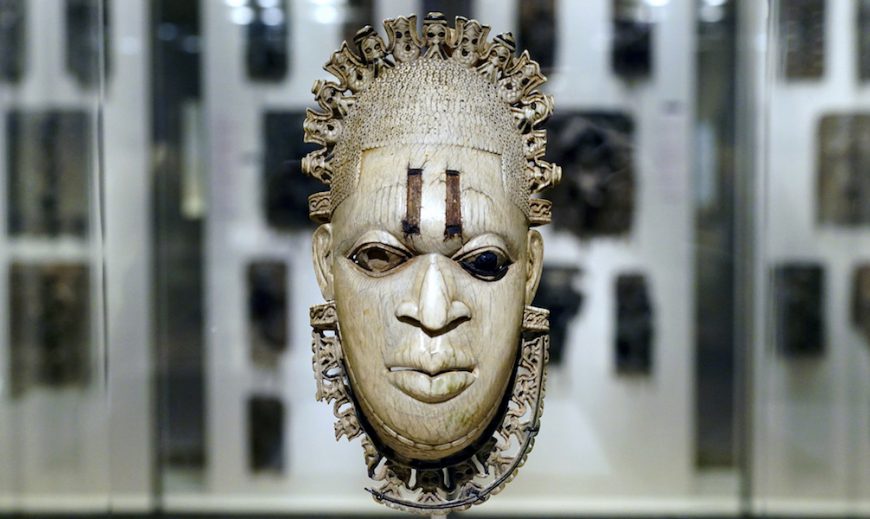How to impress your courtiers: a lesson from the Kingdom of Benin.
Benin Plaques, Museum of Fine Arts, Boston, Edo peoples, Benin kingdom, Nigeria c. 1530-1570 (Museum of Fine Arts, Boston). Speakers: Dr. Kathryn Wysocki Gunsch, Teel Curator of African and Oceanic Art, Museum of Fine Arts, Boston and Dr. Beth Harris
[0:00] [music]
Dr. Beth Harris: [0:08] We’re here in the Museum of Fine Arts in Boston, looking at the Benin plaques.
Dr. Kathryn Wysocki Gunsch: [0:11] The Kingdom of Benin is in present-day Nigeria. It was founded around the year 900. The current reigning king, Oba Ewuare II, dates his dynasty back to around the year 1250. At its height, Benin controlled a kingdom about the size of New England, with two million inhabitants.
Dr. Harris: [0:28] “Oba” is the word for king. So here we are, looking at the Oba dressed in fabulous regalia and holding symbols of his power.
Dr. Gunsch: [0:37] We know that this is the Oba because he’s wearing a phenomenal crown made of coral beads. It has this tall basketry projection called an oro projection, which is a sign of leadership. He’s wearing a tunic made entirely of coral. He’s wearing a beautifully imported damask skirt, and he’s got coral on his ankles, on his arms.
[0:56] Most importantly, he’s wearing the bead of rule on his chest.
Dr. Harris: [1:00] This coral is a beautiful deep orange red.
Dr. Gunsch: [1:03] We also see the king holding leopards, which are a metaphor for his power. The leopard is the fastest, most ferocious creature in the forest, and so it’s an emblem of the king.
[1:13] Then around his waist, we have these mudfish. The mudfish is an interesting creature in that it can bury into the mud during the dry season and survive until the rainy season. It has this ability to live in two worlds. Also, mudfish sometimes have an electrical charge and can shock you.
[1:28] He is frontal.
Dr. Harris: [1:29] He’s frontal. His body is symmetrical.
Dr. Gunsch: [1:31] This is an aesthetic choice that you see in Benin art of many media. I always ask people to mimic his posture. It’s very uncomfortable to hold your hands in line with your torso.
[1:42] That tells you that this is a little bit less naturalistic in just the posture of the king. As we look at other plaques in the collection, you’ll see that artists become more comfortable showing movement in the body.
Dr. Harris: [1:53] This plaque originally would have really gleamed.
Dr. Gunsch: [1:56] Visitors to the court noticed that they were glistening in the sun and that the Benin courtiers kept them polished. You see them brown in most European and American collections because Europeans like their bronzes to be dark, they oil them.
[2:09] So when the Benin bronzes showed up in Europe, people oiled them. Today, we’re nervous to remove that oil because it’s affected the layer of the metal and we worry about losing detail.
Dr. Harris: [2:18] Casting bronze is difficult. We’re talking about really accomplished artists.
Dr. Gunsch: [2:23] We’ll see as we look at different plaques how the artists gained greater confidence in this medium over time. What you see in the background is the most common motif. It’s a river leaf motif.
[2:33] That makes sense if we think about the coral that the king is wearing. There’s a belief that coral comes from the god of wealth, Olokun, who lives underneath the river. And so this river leaf pattern is related to that sense that the king [is] controlling wealth.
Dr. Harris: [2:46] Visitors to the court in Benin City would have seen a fabulous palace with an audience hall decorated with these plaques.
Dr. Gunsch: [2:55] That’s our understanding from visitors to the court and court tradition. They would have surrounded the pillars that supported the roof of the audience hall. It had an open ceiling that let in sunlight.
[3:06] The plaques would have gone around all four sides of those pillars. That’s the theory today.
Dr. Harris: [3:11] We can imagine people entering the audience hall, seeing the king at the other end, and looking at these images on the pillars that speak to the power of the king.
Dr. Gunsch: [3:20] It would have been very impressive, especially when you consider that copper was a medium of exchange in this period. Try to imagine wrapping the halls of the president with hundred dollar bills. It’s that kind of wealth that you’re looking at when you walk in.
Dr. Harris: [3:33] Then when you saw the Oba at the end of that audience hall dressed in this gleaming orange coral, this was quite a sight.
Dr. Gunsch: [3:41] Like courts around the world, the idea was to dazzle you when you walked in to visit the king.
Dr. Harris: [3:46] Maybe we should talk about why you can go to so many museums in the United States and in Europe and see these plaques.
Dr. Gunsch: [3:53] It seems like every museum has at least one Benin plaque. That’s dated to a terrible moment in Benin history. In 1897, due to a trade dispute, there was a war between Britain and Benin.
[4:05] The British forces invaded Benin City, burnt it to the ground, and occupied it and took at least a third of the royal treasury and sold it at auction in Europe. People were amazed by the beauty of Benin art. Very quickly museums around the world bought pieces of Benin art.
Dr. Harris: [4:19] One of my favorite plaques is of a mudfish all by himself. It reminds us that the plaques had basically two different sizes. A narrow size and a wide size.
Dr. Gunsch: [4:28] It seems that the narrow plaques are meant to work together with the wide plaques to sheathe a column. This plaque with the mudfish is a great example of the earliest work that the guild is accomplishing.
[4:39] It’s an incredibly low relief mudfish. What we mean by that is that the fish doesn’t really emerge from the surface of the plaque more than an inch, inch and a quarter.
[4:49] The artist has been fairly safe in the way that he’s molding this figure, keeping it close to the surface of the plaque.
[4:55] That’s something that might have given him confidence that it would cast well. You can see that artists are really interested in decoration. Every bit of this fish has some fine decoration on it, and especially when it was bright and shining, it would have been more impressive.
Dr. Harris: [5:12] Let’s look at a wider plaque, this one in higher relief, which was likely made later. Here, we see a very common motif in Benin art and that is three figures.
Dr. Gunsch: [5:23] Very often in Benin art, you see something called triadic symmetry, where you have a central figure and then figures on either side that are symmetrical.
Dr. Harris: [5:31] In the center of this one, we see a figure playing a drum.
Dr. Gunsch: [5:34] This is probably a warrior. He’s wearing a warrior’s bell on his chest and he’s wearing a leopard-tooth necklace, a sign that he’s in the Oba’s militia.
Dr. Harris: [5:42] I see bells also dangling from his belt.
Dr. Gunsch: [5:45] If you look closely, those bells are attached with a leopard-skin leather, which is a symbol of his relationship to the Oba.
Dr. Harris: [5:53] He’s larger than the figures on either side of him. This is something that we also see in Benin art often.
Dr. Gunsch: [5:59] Although it’s interesting, in this corpus you start to see artists abandoning that. That might be because it makes the side figures much harder to see from a distance. In later plaques, we start to see three figures who are all the same size, even if one of them is hierarchically more important.
Dr. Harris: [6:16] I’m seeing so much more movement here.
Dr. Gunsch: [6:18] Yes. If we think of the mudfish we looked at as the earliest kind of plaque, very simple, very flat, the farther along we go, the more fun we can see the artists are having with the medium. Here, the arms of the drummer are off the plaque’s surface.
[6:34] They’re touching that drum in a way that feels believable and comfortable to mimic with your own body, same with the attendants who are playing a double gong. Their arms are off of the surface of the plaque. The artist is still a little cautious. The arms are attached to their chests, and yet we get that sense that they are moving out to play this instrument.
Dr. Harris: [6:53] Their heads tilt slightly. There’s a real sense of animation to the figures.
Dr. Gunsch: [6:57] Even the way the bells are tipped, it seems like they’ve just moved or come to rest. For me, at least, that helps me imagine the sounds these figures are making.
Dr. Harris: [7:06] These are figures who are entertaining the king.
Dr. Gunsch: [7:09] These were likely in a procession coming to or from the Oba’s palace.
Dr. Harris: [7:13] Now we’re looking at another plaque of three officials, but these figures are all the same size.
Dr. Gunsch: [7:19] It’s unlikely that they are the same hierarchy. It seems that the figure with the helmet is a more important member of the court than these two figures with the crown and the feathers.
Dr. Harris: [7:28] We can tell that because of that coral necklace that he’s wearing.
Dr. Gunsch: [7:32] These coral necklaces are given by the king to important courtiers. The more coral you’re wearing, the greater favor you have with the king. We know that this figure wearing the high coral collar, which is called an odigba, was quite important.
Dr. Harris: [7:44] We see the leopard’s-tooth necklaces and also the warrior bells.
Dr. Gunsch: [7:48] They’re all wearing emblems that they are members of Benin militias. If you look at their stomachs, you can see a stylized head of a leopard. This is a kind of armor made out of a stiffened leather.
Dr. Harris: [7:58] This is so much more complex. The decorative forms of their regalia stand out more. We have more of a contrast of light and dark.
Dr. Gunsch: [8:08] You could look at this plaque for an hour and see different textures. You can see those cascades of bells on the figures to the left are different from the bells worn by the figure in the helmet. They’re attached differently. The skirts are different. There are different levels to each figure’s skirt.
[8:24] There’s many different kinds of textile depicted. The figures are wearing different bracelets. The figures on the left have upper-arm decorations that are separate.
Dr. Harris: [8:32] These are figures that would be processing toward the king.
Dr. Gunsch: [8:35] Because that central figure is holding an offering box, we know that those carry either a gift from a king to his subject or taxes from a subject to the king’s court.
Dr. Harris: [8:44] The figures on either end in their left hand carry a sword that really emerges from that background. We’ve moved from that low relief to higher relief. I can see how these figures would be more readable across a large space.
Dr. Gunsch: [8:58] They have much larger eyes. The way that the eyes are set into the head, it’s a deeper recess, which gives us a better legibility to see those eyes across the space. The eyeball itself is tipped forward, making it easier for light to reach that part of the plaque and for us to see it from a distance.
Dr. Harris: [9:14] So we see stylistic change as we look at this corpus of more than 850 plaques.
Dr. Gunsch: [9:19] You can start to see how the artists are developing the medium, how they’re changing composition over time, how they’re learning from the act of creating this large commission. It was probably made by two kings, King Esigie and his son Orhogbua. When Esigie took the throne in 1517, he had great problems with his court.
[9:38] He created this commission to imagine the court that should be. It seems to have succeeded, to have created that sense of awesomeness of the king’s power. That contributed to the way that he repaired relationships with his court and assured the dominance of the Benin king over his subjects.
[9:54] In the museum, we look at these frontally, but in the palace, you would have navigated around the columns in order to sit down. And then these figures would have taken on even greater sense of life and vitality. They’re becoming almost courtiers themselves, present in space with you.
Dr. Harris: [10:09] What an impressive environment for an audience with the Oba.
[10:12] [music]
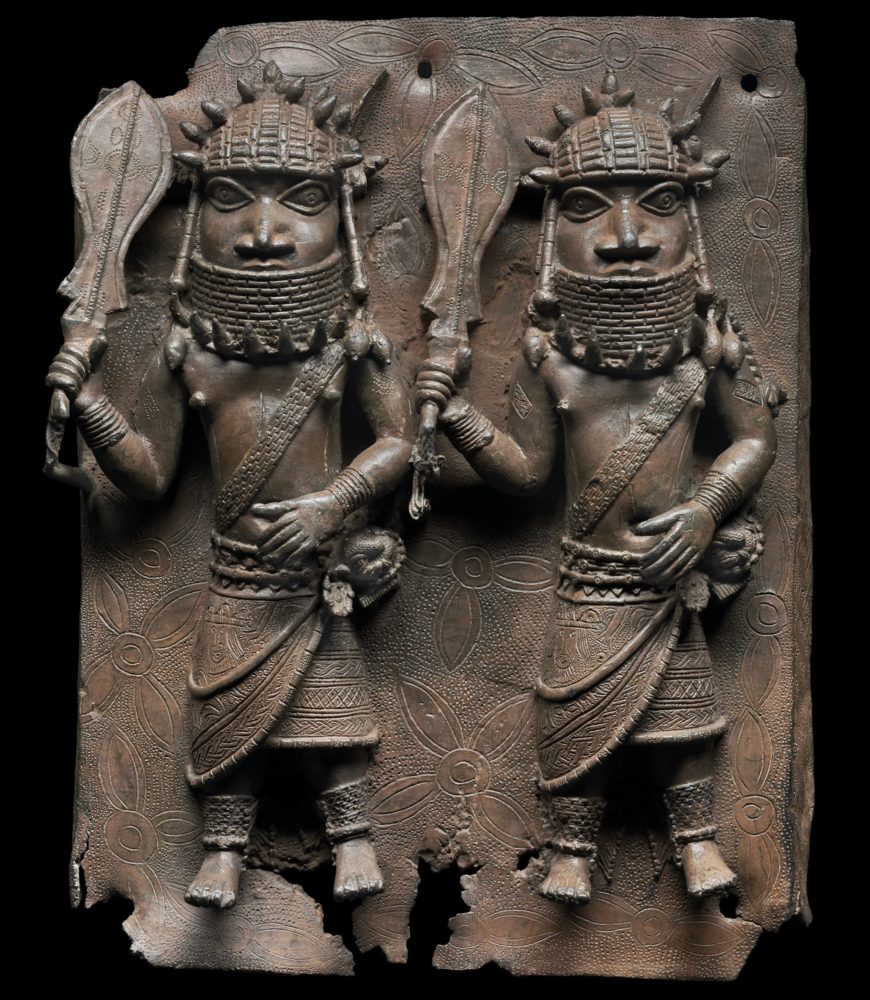
Artist Unidentified, Relief plaque showing two officials with raised swords, c. 1530-1570, copper alloy (Robert Owen Lehman Collection, Courtesy Museum of Fine Arts, Boston)
Designed to impress
Think of the last time you saw an interior space that impressed you. Whether you were watching Game of Thrones or reality TV, walking onto a college campus or into a major museum for the first time, some spaces are designed to wow—and intimidate—visitors. The audience hall in the palace in Benin City, in present-day Nigeria, was a space made to wow. It communicated to visiting ambassadors, traders, courtiers, and subjects the power and wealth of the Oba (the king).
Privileged regalia
During the sixteenth century, the pillars of the Oba’s audience hall would have been covered in bronze relief plaques like the one above. Two men stand with their feet firmly planted on an imagined plane. The men wear coral beaded regalia from head to toe—coral crowns, special high collars called odigba that signal their elite rank, beaded sashes across their chests, and beaded bands around their wrists and ankles.
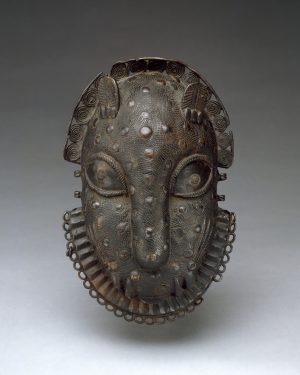
Leopard-head hip ornament, 16th – 19th century, 19.1 x 12.1 x 5.4 cm, Edo peoples, Benin, Nigeria (The Metropolitan Museum of Art)
Only the Oba could grant permission to wear coral, an imported luxury related to his control of overseas trade with Portugal and, later, the Dutch, English, and French. The coral and the river-leaf pattern in the background also refers to Olokun, the god of wealth whose palace is under the sea.
The scars on the men’s chests, called iwu, were the mark of Benin subjects until the late nineteenth century. While the men’s attire signals their position within the court and their reliance on the king, their gesture announces that they are loyal and obedient subjects. Each figure holds a special fish-shaped sword, called an eben, aloft. Even today, these swords are used to dance in honor of the Oba. During palace festivities, courtiers throw them spinning into the air and catch them before they touch the ground — a display to honor the king.
Decoration for a grand palace
The plaque above was originally displayed on a pillar in an audience hall located deep within the palace. Pillars held up the roof of a veranda with built-in seating that ran around a large open-air courtyard in the center.
Historical accounts from visiting traders to Benin City suggest that the audience courtyard was roughly 30 by 60 meters (98.43 x 196.85 feet) [1] and could fit 500 people.[2] Likely beginning during the reigns of Oba Esigie (who ruled from 1517 to the 1550s) and his son Orhogbua (who ruled from the 1550s–1570s), the pillars surrounding the audience court were covered with more than 850 bronze relief plaques like this one.
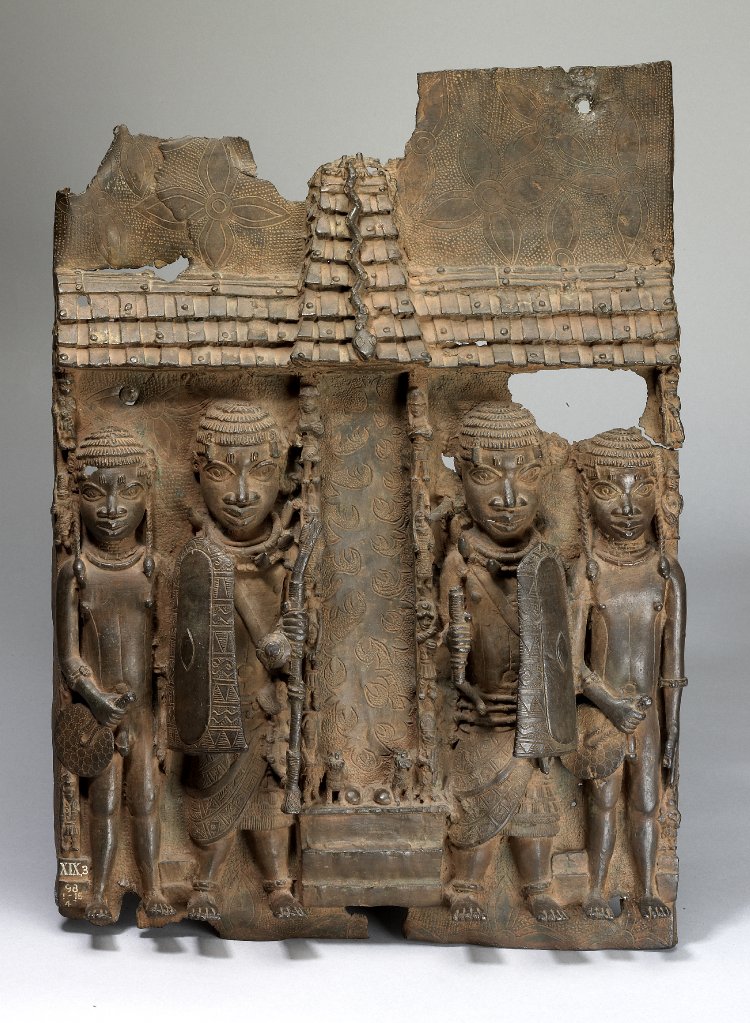
Plaque depicting an audience hall, 16th -17th century, 55 x 39 cm, Edo peoples, Benin, Nigeria (photo: British Museum, CC BY-NC-SA 4.0)
A surviving plaque shows what the audience hall must have looked like at the time, with a high roof ornamented by a cast-bronze snake and depictions of courtiers and warriors on the plaques decorating the pillars below. Hanging on all sides of the columns, the plaques would have created the impression that the pillars were of solid bronze — a form of currency at the time.
The plaques were deinstalled from the audience court in Benin City before the beginning of the eighteenth century, and kept in a storeroom within the palace until the British invasion of 1897. They are kept today in museums in Nigeria, the UK, Germany, Austria, and the United States. Recent research suggests that the plaques were made in three separate periods.
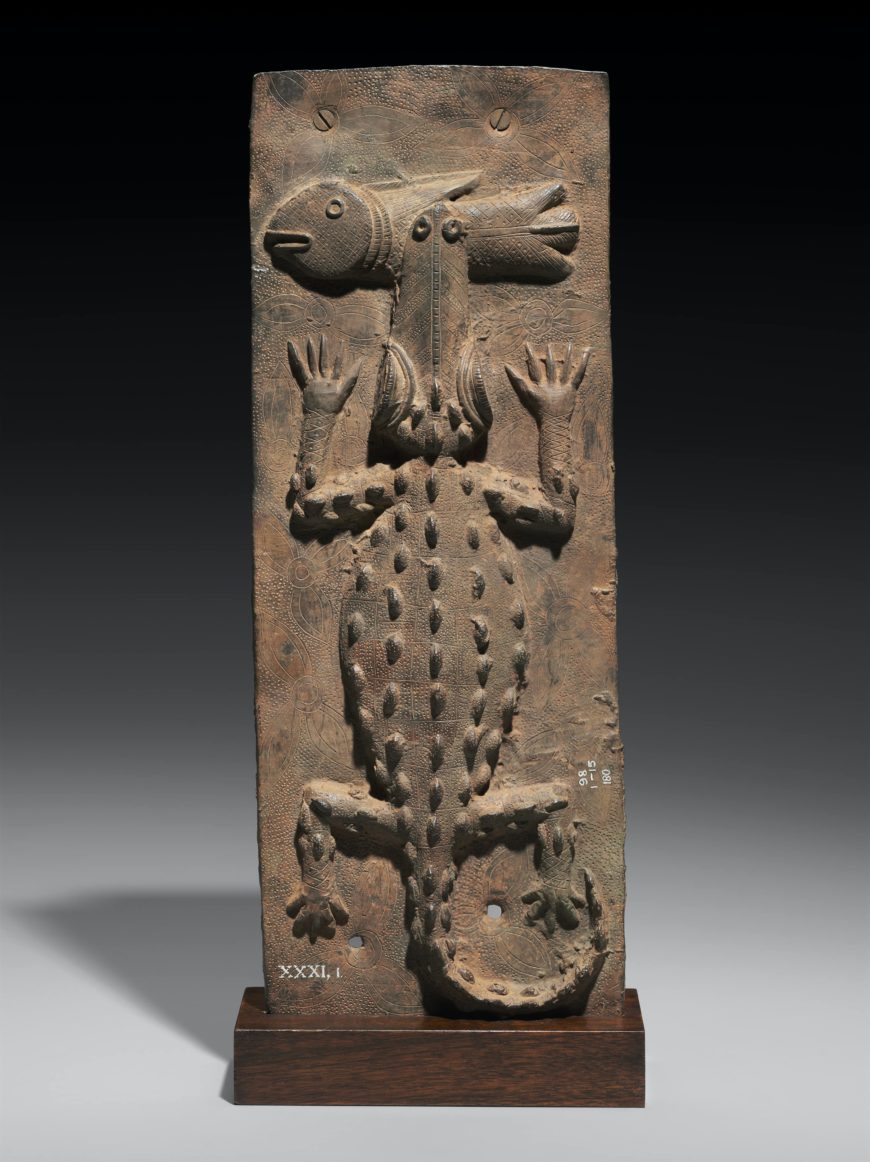
Artist Unidentified, Relief plaque showing a crocodile with mudfish, c. 1530-1570, copper alloy (Robert Owen Lehman Collection, Courtesy Museum of Fine Arts, Boston)
Casting in bronze
The plaques were all made using the lost wax method, where an artist creates a form in wax, covers it in layers of clay, and bakes the mold until the wax runs out. The artist then pours molten bronze into the hardened clay form, and breaks the form to release the final casting.
The early plaques are all low reliefs, meaning that they are fairly flat, without many details that rise off the surface of the plaque, like this plaque depicting a crocodile biting a mudfish.
From low to high relief
Low reliefs are easier to cast, because the artist does not need to worry about molten metal reaching each part of the form before it cools. In the later series of plaques, however, artists cast high reliefs, meaning that they have greater depth. In the plaque discussed above, the thin swords are fully free of the plaque surface, a daring compositional choice that required careful management of the hot bronze to fill the form.

Detail of relief plaque showing two officials with raised swords, showing the high relief of the bodies and fully-free swords (photo: Steven Zucker, CC BY-NC-SA 4.0)
The switch to high relief suggests that the artists were becoming more confident in the medium of bronze reliefs. It may also reflect the artists’ observations of how the completed reliefs looked once installed on the palace pillars. The later plaques, characterized by high-relief compositions of human figures that fill the entire surface, would have been easier to see from across the large courtyard.
Art for legitimacy
Why did the kings of Benin commission this ambitious program of court decoration? Oba Esigie fought his brother for the throne and then faced an attack from a neighboring army and the disobedience of his senior courtiers. He may have commissioned the plaques to assert his wealth and power to internal and external enemies, creating the impression of a strong monarchy despite the rocky start to his reign.
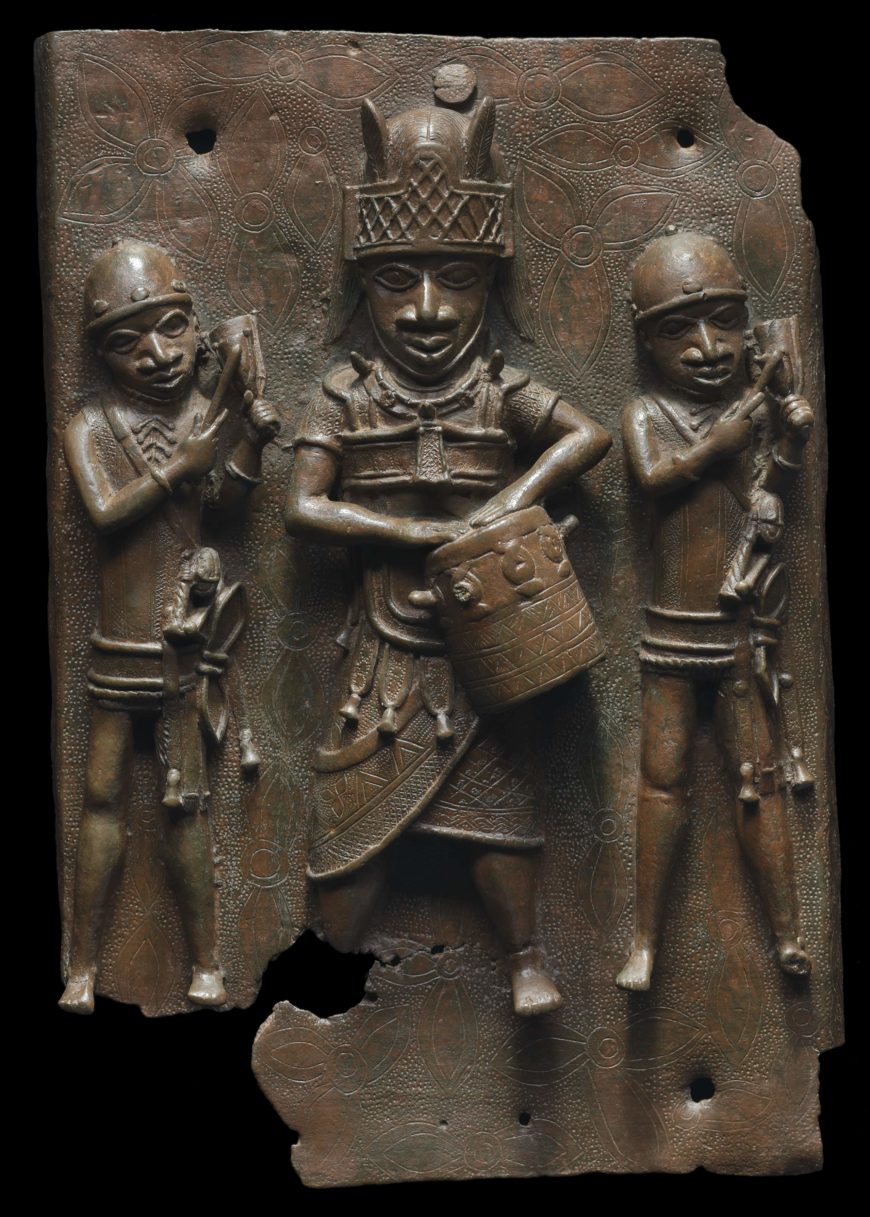
Artist Unidentified, Relief plaque showing a dignitary with drum and two attendants striking gongs, c. 1530-1570, copper alloy (Robert Owen Lehman Collection, Courtesy Museum of Fine Arts, Boston)
The earlier plaques depict elements of regalia and metaphorical animals relating to the Oba, as well as courtiers and warriors depicted in simple, three-person compositions in hierarchical scale, where the most important person is largest. All of these motifs indirectly allude to the king and his power. The narrative presented by the later plaques more explicitly honors the might and authority of the king.
Rather than referring to the Oba through court regalia or metaphorical creatures, these compositions depict people in direct service to the crown: participating in processionals, battles or ceremonies, like the men holding the eben dance swords. The plaque commission was likely one element in cementing Esigie’s authority. By the end of his reign and through the reign of his son Orhogbua, the court gave greater support to the monarchy.


